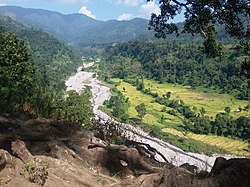|
Jhapa District
Jhapa District (Nepali: झापा जिल्ला; ⓘ) is a district of Koshi Province in eastern Nepal named after a Rajbanshi Surjapuri language word "Jhapa", meaning "to cover" (verb). The 2021 Nepal Census, puts the total population of the district at 994,090.[3] The total area of the district is 1,606 square kilometres. The lowlands of Limbuwan (present-day terai lands of Sunsari, Morang and Jhapa) was collectively known as Morang since the time of King Mawrong of 7th century. In the beginning of 1400 AD, Morang Kingdom patriated from Kingdom of Ilam and Kingdom of Mikluk Bodhey (Choubise) and started ruling on its own.[4] LocationJhapa is the easternmost district of Nepal and lies in the fertile Terai plains. It is part of the Outer Terai. Jhapa borders with Ilam in the north, Morang in the west, the Indian state of Bihar in the south and the Indian state of West Bengal to the southeast and east. Geographically, it covers an area of 1,606 km2 (620 sq mi) and lies on 87°39’ east to 88°12’ east longitude and 26°20’ north to 26°50’ north latitude.[5] Climate and geographyJhapa receives 250 to 300 cm of rainfall a year, and mostly during the monsoon season in the summer, and its hilly northern area receives more rainfall than the south.[6] The maximum temperature recorded is 42.5 °C in summer and 1 °C in winter.[7] The lowest elevation point is 58 meters which is the lowest land in Nepal and the highest elevation point is 500 meters from mean sea level.[5]
Administrative divisionsJhapa consists of 15 administrative divisions including eight municipalities and seven rural municipalities. Each division has wards according to the demographic and geographic size. These are: Municipalities
Rural municipalities
VillagesDemographicsAt the time of the 2011 Nepal census, Jhapa District had a population of 812,650. As first language, 55.7% spoke Nepali, 31.3% Rajbanshi, 5.6% Limbu, 5.5% Maithili, 3.6% Santali, 2.5% Rai, 2.4% Urdu, 2.1% Tamang, 1.5% Newar, 1.5% Tajpuriya, 1.2% Magar, 1.0% Dhimal, 0.8% Tharu, 0.7% Bengali, 0.6% Gurung, 0.5% Meche, 0.4% Bantawa, 0.4% Bhojpuri, 0.4% Hindi, 0.4% Rajasthani, 0.2% Chamling, 0.2% Danuwar, 0.2% Sunuwar, 0.2% Uranw/Urau, 0.1% Bhujel, 0.1% Ganagai, 0.1% Haryanvi, 0.1% Kisan, 0.1% Kulung, 0.1% Kumhali, 0.1% Majhi, 0.1% Sherpa, 0.1% Yakkha and 0.4% other languages.[9] Ethnicity/caste: 23.8% were Hill Brahmin, 15.7% Chhetri, 29.1% Rajbanshi, 8.6% Limbu, 4.5% Rai, 3.8% Satar/Santal, 3.3% Newar, 3.2% Musalman, 3.0% Kami, 2.9% Tamang, 2.2% Magar, 1.9% Damai/Dholi, 1.5% Tajpuriya, 1.3% Sanyasi/Dasnami, 1.2% Gangai, 1.2% Tharu, 1.1% Dhimal, 0.9% Gharti/Bhujel, 0.9% Gurung, 0.9% Majhi, 0.7% Teli, 0.6% Sarki, 0.6% Yadav, 0.5% Bengali, 0.5% Marwadi, 0.5% Meche, 0.5% other Terai, 0.4% Terai Brahmin, 0.4% Hajam/Thakur, 0.4% Musahar, 0.3% Danuwar, 0.3% Dhanuk, 0.3% Halwai, 0.3% Kumal, 0.3% Sunuwar, 0.2% Jhangad/Dhagar, 0.2% Kathabaniyan, 0.2% Kurmi, 0.2% Mallaha, 0.2% Sherpa, 0.1% Baraee, 0.1% Chamar/Harijan/Ram, 0.1% Chamling, 0.1% other Dalit, 0.1% Dom, 0.1% Dusadh/Paswan/Pasi, 0.1% other Janajati, 0.1% Kalwar, 0.1% Kayastha, 0.1% Kewat, 0.1% Khawas, 0.1% Kisan, 0.1% Koche, 0.1% Koiri/Kushwaha, 0.1% Kulung, 0.1% Munda, 0.1% Nuniya, 0.1% Punjabi/Sikh, 0.1% Rajput, 0.1% Sonar, 0.1% Sudhi, 0.1% Tatma/Tatwa, 0.1% Thakuri, 0.1% Yakkha and 0.5% others.[10] Religion: 79.9% were Hindu, 8.3% Kirati, 4.8% Buddhist, 3.2% Muslim, 1.9% Christian, 1.4% Prakriti and 0.3% others.[11] Literacy: 75.0% could read and write, 1.8% could only read and 23.2% could neither read nor write.[12] Jhapa District has average population density of around 619 per square kilometer. The district population growth rate is 1.93%. However, the growth is balanced and in-migration is rapidly increasing day to day into the district. At the time of the 2021 Nepal census, Jhapa District had a population of 994,090 making it the 4th largest district in Nepal after Kathmandu, Morang and Rupandehi. Being at the cross-roads of the eastern hills and the eastern Terai, Jhapa has huge ethnic diversity with 110 castes/ethnic groups represented. The largest communities are Bahun and Chhetri . Other communities include the Janajati Limbu and other Kirati peoples, Dalit communities like Kami and Damai, as well as Tamang, Newar and Magar and Adivasi communities like the Rajbanshi/Tajpuriya, Gangai or Ganesh, Santal, Tharu and Dhimal in the Terai.
International BordersJhapa borders the Indian state of Bihar to the south and the Indian state of West Bengal to the east. Jhapa is an eastern entry point of Nepal from India. Kakarbhitta-Mechinagar border lies in Jhapa and is an important trade point for Nepal. EducationAmong 77 districts, Jhapa has a literacy rate of 75.2%, higher than the national average.[14] There are enough primary schools, secondary schools, high schools and colleges available both from private sector and the government. Notable peopleJhapa district is home to notable personalities including one former prime minister and two former deputy prime ministers.
References
External linksWikimedia Commons has media related to Jhapa District.
|
|||||||||||||||||||||||||||||||||||||||||||||||||||||||||||||||||||||||||||||||||||||||||||||||||||||||||||||||||||||||||||||||||||||||


